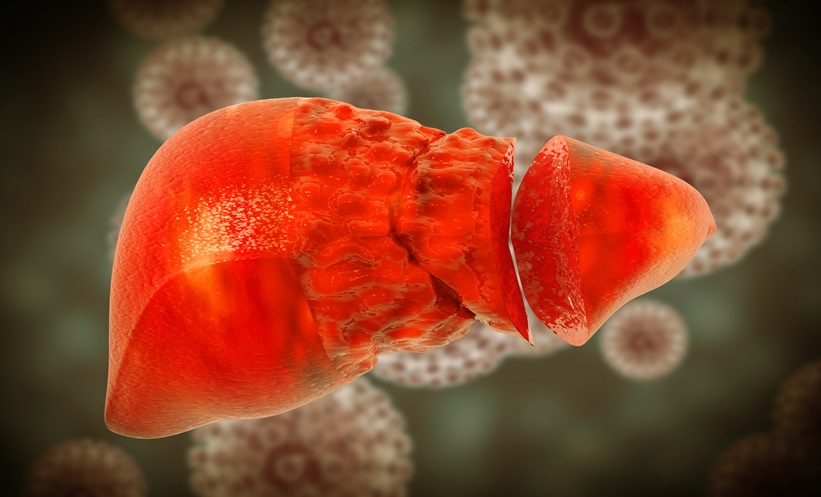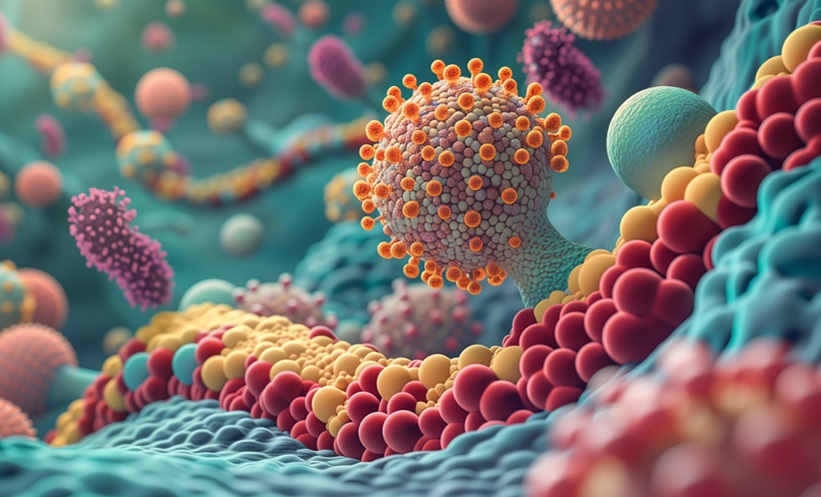The following selected abstracts were the pinnacle of those showcased at the European Association for the Study of the Liver (EASL) Congress 2023, exploring current topics ranging from the gut microbiome diversity and cirrhosis, to hepatitis and hepatocellular carcinoma.
Citation: EMJ Hepatol. 2023;11[1]:34-39. DOI/10.33590/emjhepatol/10309696. https://doi.org/10.33590/emjhepatol/10309696.
![]()
Advanced Hepatocellular Carcinoma: Myeloid IL-8 Enrichment and Immunotherapy Resistance
DURABLE response to treatment in patients with advanced hepatocellular carcinoma (HCC) is confined to a small fraction of patients, despite emerging therapeutic options, including immunotherapy. The ineffectiveness of immune checkpoint blockade (ICB) and resistance acquisition caused by the immunosuppressive drivers, such as inflammatory cytokines and myeloid cells, had to be tackled. A research team at The Chinese University of Hong Kong, China, therefore sought to analyse the role of myeloid IL-8 in ICB-resistance mechanisms, aiming to intervene the IL-8 pathway through the inhibition of its receptor using a CXCR2 antagonist.
Patients with advanced HCC were recruited prior to pembrolizumab therapy, resulting in the inclusion of 26 participants. Baseline and on-treatment biopsies were collected, with single-cell RNA transcriptomic analysis performed. Simultaneously, circulating IL-8 levels were quantified in peripheral blood samples. To evaluate the efficacy of CXCR2 pathway inhibition using AZD5069 in potentiating ICB response, an orthotopic mouse model with ICB resistance was used. The mouse model was generated through serial in vivo passaging of anti-PD-1 residual tumour. High-parameter flow cytometry was used to profile the immune landscape in the tumour microenvironment.
Results showed that patients with a higher baseline plasma IL-8 had worse overall survival than those with lower IL-8 (hazard ratio [HR]: 2.899; 95% confidence interval [CI]: 1.112–7.558; p=0.0294). Single-cell RNA sequencing suggested IL-8 originated from myeloid cell clusters in tissue biopsies. Specifically, the upregulated expression of IL-8 on polymorphonuclear myeloid-derived suppressor cells was strongly associated with a poorer progressive-free survival (HR: 2.327; 95% CI: 0.867–6.248; p=0.0352). Inhibition of the IL-8 receptor with a CXCR2 antagonist improved the survival benefit of anti-PD-L1 treatment in the mouse model. Mechanistically, the suppression of CXCR2 signalling hindered the recruitment of myeloid-derived suppressor cells to the tumour site. In turn, the immunosuppression in the tumour microenvironment favouring ICB treatment was reverted.
Overall, the research team demonstrated the importance of the myeloid IL-8/CXCR2 pathway in ICB resistance in a cohort with advanced HCC. This paves the way for IL-8 to become a novel prognostic target for immunotherapy. Subsequently, blocking CXCR2 could reduce myeloid-derived suppressor cell trafficking, and overcome ICB-resistance in a pre-clinical HCC model. This could be a promising combination regimen in future.
Role for Faecal Microbiota Transplant in Advanced Liver Cirrhosis?
REDUCTION in gut microbiome diversity, alongside gut barrier damage and bacterial translocation, occurs in patients with liver cirrhosis, resulting in an increased infection risk and impaired microbial metabolism of ammonia. The latter can lead to hepatic encephalopathy.
A group of researchers led by Lindsey Edwards, King’s College London, UK, conducted a placebo-controlled, single-blinded, randomised controlled feasibility trial to determine whether faecal microbiota transplant (FMT) could improve intestinal barrier function, mucosal immunity, and microbial ammonia metabolism in patients with advanced liver cirrhosis (defined as Model for End-Stage Liver Disease score of 10–16).
Stool and blood samples were taken at baseline to evaluate the impact of FMT on gut microbiota modulation and patient inflammatory status. Patients were randomised on a 3:1 basis to receive either liquid frozen FMT or placebo. In total, 32 patients were endoscopically delivered 50 g of liquid frozen FMT directly into the jejunum. Stool and blood samples were subsequently collected at Days 7, 30, and 90 to evaluate changes in the microbiome and inflammation levels.
Using metagenomic sequencing, the authors found a significant donor engraftment and increased recipient species richness following FMT. FMT also resulted in significantly reduced carriage of Enterococcus faecalis and other pathobionts, which are over-represented in patients with liver cirrhosis; reduced inflammatory biomarkers; and increased gut barrier repair markers.
Furthermore, reductions in 30-day plasma ammonia were seen in those treated with FMT (p=0.0006), and 30-day faecal ammonia was higher in the FMT group than the placebo group (p=0.0110 and p=0.0250, respectively). Faecal proteomics showed increased denitrification and ammonification microbial enzymes in the stool of patients treated with FMT compared with those treated with placebo (p=0.031), plus an increase in enzymes involved in nitrogen assimilation and excretion via the urea cycle.
The researchers concluded that the findings highlight the impact of FMT on pivotal factors in hepatic encephalopathy pathogenesis. FMT led to increased ammonia metabolism by reducing serum microbial-associated ammonia production, increasing faecal ammonia excretion, and enhancing anaerobic L-aspartate metabolism. FMT also altered the gut microbiota, and promoted gut barrier inflammatory repair.
Improving Outcomes in Patients with Hepatitis C and Hepatocellular Carcinoma
IMPROVED clinical outcomes and survival rates have been uncovered in patients with chronic hepatitis C and hepatocellular carcinoma (HCC) by achieving sustained virological response. The current research was presented at the EASL Congress 2023, aiming to provide real-world data on virological response and overall survival in patients with hepatitis C-related HCC, who were treated with direct acting antiviral therapies at differing time points.
This investigation was a retrospective cohort study including patients who were hepatitis C positive, and were diagnosed with HCC, managed at King’s College Hospital, London, UK, between January 2015–2020. Follow-up data was collected until end points, including death, liver transplantation, or April 2022. Patients with historical or active HCC were included, and information about tumour stage and treatment modality were collected, with tumour treatment defined as curative (ablation, resection, or liver transplantation) or non-curative (transcatheter arterial chemoembolisation, selective internal radiation therapy, stereotactic body radiation therapy, or systemic therapy). Primary outcome was comparison of sustained virological response in both HCC groups, and secondary outcome was measuring overall survival.
The cohort was made up of 98 patients, 81 (83%) of whom had active HCC at the time of direct acting antiviral therapy and 11 (17%) with historical HCC. In total, 85% were cirrhotic with compensated liver disease, and 52% received curative HCC therapy. Overall, participant sustained virological response rate was 82%, but this decreased to 76% in patients with active HCC. Multivariate analysis highlighted that the presence of active HCC at time of hepatitis C virus therapy (hazard ratio [HR]: 5.46; 95% confidence interval [CI]: 1.25–23.82; p=0.024) and the number of HCC nodules (HR: 2.19; 95% CI: 1.08–4.41; p=0.029) were the only factors associated with not achieving sustained virological response. Failure to achieve sustained virological response (HR: 9.9; 95% CI: 2.16–46.01; p=0.003), presence of advanced chronic liver disease (Child Pugh B/C: HR: 3.7; 95% CI: 1.46-9.58), and administration of non-curative treatments (HR 3.2; 95% CI: 1.19–8.44) were associated with mortality. Overall survival was higher in those who achieved sustained virological response (130 m; 95% CI: 85–174), and this was consistently irrespective of treatment timing (historical HCC: 119 m; 95% CI: 102-135; active HCC: 78 m; 95% CI: 67-88), tumour stage (Barcelona Clinic Liver Cancer [BCLC]: A 104 m; 95% CI: 93-116; BCLC B/C: 60m; 95% CI: 63-85), and treatment intent (curative: 117 m; 95% CI: 107–128; and non-curative: 75 m; 95% CI: 59–91; log-rank test p=0.003).
The researchers of this investigation acknowledged that the optimal timeframe for delivering antiviral therapy in those with active infection remains unclear, and warrants follow-up in future study. They were able to conclude that treating patients with hepatitis C and HCC is feasible with acceptable sustained virological response rates. Other key points from this study were that failure to achieve sustained virological response is one of the main factor associated with mortality, and overall survival is higher in those who achieve sustained virological response, independent of tumour stage or treatment modality.
Utilising Spatial Proteotranscriptomics in Patients with At-Risk Non-alcoholic Steatohepatitis
During the EASL Congress 2023, Dina Tiniakos, Newcastle University, Translational and Clinical Research Institute, UK, presented a study which aimed to resolve the spatial heterogeneity of the macrophage population in at-risk non-alcoholic steatohepatitis (NASH), and their relationship to histopathological features.
The researchers performed GeoMx® Human Whole Transcriptome Atlas (Nanostring, Seattle, Washington, USA) profiling on eight biopsies from patients with NASH fibrosis Stage 3. They selected the regions of interest based on the presence of portal inflammatory infiltration, steatosis with lobular inflammation and/or lipogranulomas, and parenchyma without steatosis. For segmentation of different macrophage, immune cell, and epithelial cell populations from each region, fluorescent CD6, CD45, and pan-keratin markers were used. In total, 80 segments were processed for high throughput RNA sequencing.
The authors explored the clinical relevance of the identified differentially expressed genes in extant bulk RNA sequencing data from 206 patients with non-alcoholic fatty liver disease. By using the Multiple Iterative Labelling by Antibody Neodeposition (MILAN) method, the key targets were validated on a protein level. An expert liver pathologist scored all the samples, referring to the semi-quantitative Nonalcoholic Steatohepatisis Clinical Research Network (NASH-CRN) Scoring System.
By comparing parenchymal steatohepatitis-associated (SH-) macrophages with portal (PT-) macrophages and Kupffer cells from parenchyma without steatosis, they identified 352 and 218 differentially expressed genes, respectively. SH-macrophages showed features of both monocytes (high expression of LSP1, glycoprotein NMB, and lysozyme) and mature macrophages (high MSR1 expression), when compared to Kupffer cells in areas without steatosis. Additionally, metabolic- and phagocytosis-related genes were heightened in SH-macrophages.
With regard to the clinical relevance of key markers in the bulk RNASeq data, CCL19 expression was linearly collated with the fibrosis stage, lobular inflammation, and hepatocyte ballooning scores; however, this was not observed with the steatosis grade. GPNMB and lysozyme mRNA expression displayed predominantly NASH activity, attributable to the significant association with steatosis, lobular inflammation, and hepatocyte ballooning scores, but not with fibrosis.
Tiniakos and colleagues demonstrated a steatohepatitis-associated macrophage subpopulation in patients with at-risk NASH. By comparing to portal macrophages and Kupffer cells from non-steatotic liver parenchyma, they identified unique characteristics to highlight macrophage heterogeneity. Tiniakos also demonstrated the clinical relevance of steatohepatitis-associated macrophages in the grading and staging of the non-alcoholic fatty liver disease spectrum.
Albuminome Signatures: Predicting Severity and Early Mortality in Acute Liver Failure
BIO-MOLECULAR analysis of serum albumin unveils signatures indicative of severity (need for emergency liver transplantation) and early mortality in acute liver failure (ALF), according to researchers from the Institute of Liver and Biliary Sciences (ILBS), New Delhi, India.
Mortality associated with ALF corresponds to changes in plasma albumin function and levels. To assess changes in albumin and the relationship to ALF disease severity and mortality further, the authors recruited 200 patients with a diagnosis of ALF, and 25 healthy controls. Patients were split into a training cohort, comprised of non-survivors of ALF (n=32), survivors of ALF (n=8), and health controls (n=5); and a test cohort for validation, comprised of the remaining recruited patients.
In the training cohort, albumin samples were purified and analysed for modification, functionality, and bounded multi-omics signatures. Subsequently, validation was performed in the test cohort using five machine learning algorithms.
Albumin oxidative state, plasma oxidation, and glycosylation was higher in patients with ALF, particularly non-survivors of ALF (p<0.05). Multivariate partial least squares-discriminant analysis and α/β-diversity indices of purified albumin from non-survivors of ALF showed significant multi-omics alterations (p<0.05). The bio-molecular albumin profile for non-survivors of ALF displayed significant increases in bound biomolecules linked to inflammation, amino acid metabolism, bacterial peptides, bile acids, mitochondria breakdown, and advance glycation end-products signalling. Increased bacterial taxa functionality was also found to correlate with serum triglyceride, metabolites, and phosphatidylserine in non-survivors of ALF(R2>0.7; p<0.05).
Multi-omics signature-based probability of detection was >90% for non-survival in ALF, which correlated with clinical parameters and albumin functionality (R2>0.85). There was a 98% diagnostic efficiency in metabolite probability of detection for ALF early mortality prediction (area under the curve: 0.98; 95% confidence interval: 0.95–1.0; p<0.05). In non-survivors of ALF, increased binding of L-acetylcarnitine, L-carnitine, N-(-3ydroxybutanoyl)-L homoserine lactone, nicotinic acid, and pregnenolone lactone to albumin was seen. Validation accuracy for early mortality prediction was >98%.
The authors concluded that albuminome signatures can help differentiate patients with ALF who are at greater risk of early mortality, or need emergency liver transplantation. Therefore, this could potentially be used to aid clinicians in clinical decision-making.







